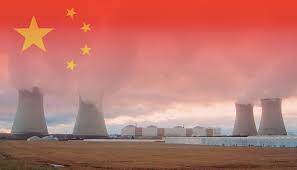Published on Wednesday August 10 2011 (AEST)

 In the wake of the Fukushima meltdowns, some nations are looking to move away from nuclear power. But not China, which is proceeding with plans to build 36 reactors over the next decade. Now some experts are questioning whether China can safely operate a host of nuclear plants.
In the wake of the Fukushima meltdowns, some nations are looking to move away from nuclear power. But not China, which is proceeding with plans to build 36 reactors over the next decade. Now some experts are questioning whether China can safely operate a host of nuclear plants. by david biello
Giant rings of prefabricated concrete and steel lower into place at the Sanmen Nuclear Power Station in Zhejiang, China. Inside the rising containment building, a 340-ton chunk of forged steel forms the nuclear reactor’s vessel, which arrived from South Korea late last month. Inside that vessel, if all goes well, uranium fuel rods clad in zirconium alloy will by 2013 begin to fission, heating water to create the steam that will spin a turbine and produce electricity without the heavy greenhouse gas emissions of burning coal.
 Workers swarm over the scaffolding of the buildings surrounding this core at the world’s newest nuclear power plant — the first to use a new type of nuclear reactor, the so-called AP 1000 from Westinghouse, though a similar reactor at Haiyang in Shandong Province is not far behind. And those two reactors represent only a fraction of the 20 nuclear power plants — and 36 nuclear reactors — China plans to build in the next decade. Already, Sanmen’s second AP 1000 reactor is under construction and scheduled to be completed in 2014.
Workers swarm over the scaffolding of the buildings surrounding this core at the world’s newest nuclear power plant — the first to use a new type of nuclear reactor, the so-called AP 1000 from Westinghouse, though a similar reactor at Haiyang in Shandong Province is not far behind. And those two reactors represent only a fraction of the 20 nuclear power plants — and 36 nuclear reactors — China plans to build in the next decade. Already, Sanmen’s second AP 1000 reactor is under construction and scheduled to be completed in 2014.
In the wake of the meltdowns at the Fukushima Daiichi nuclear power plant in Japan, many nuclear nations have reassessed their fission future.
 Japan has cast aside plans to build more nuclear power plants, Germany plans to abandon nuclear power by 2022, and Italy will no longer restart a long moribund nuclear industry. Even nuclear stalwarts such as France — which gets 80 percent of its electricity from nuclear reactors — have begun to analyze what eliminating nuclear might mean as part of a broader energy strategy for 2050, although the French government remains supportive of fission’s role in the energy mix.
Japan has cast aside plans to build more nuclear power plants, Germany plans to abandon nuclear power by 2022, and Italy will no longer restart a long moribund nuclear industry. Even nuclear stalwarts such as France — which gets 80 percent of its electricity from nuclear reactors — have begun to analyze what eliminating nuclear might mean as part of a broader energy strategy for 2050, although the French government remains supportive of fission’s role in the energy mix.
But for the world to have any hope of constraining greenhouse gas emissions, nuclear power may have to play a role. The Japanese Environment Ministry notes that shuttering the 18 nuclear power plants in the country would boost CO2 emissions by as much as 210 million metric tons — a rise of nearly 17 percent from current levels. The International Energy Agency suggests that 30 new nuclear reactors must be built each year between now and 2050 to cut CO2 emissions in half.
As a result of such climate change concerns, as well as the need for more power in developing nations, more than 60 reactors are under construction around the world today in countries like India, Russia. and South Korea. Even the U.S. is currently building one new reactor — the second unit at Watts Bar in Tennessee.
 But no other country comes close to China, with 26 reactors now under construction — nearly half of all the nuclear reactors being built worldwide, according to the World Nuclear Association. That percentage only looks set to increase as other nations call off nuclear plans. China has also become the world’s living laboratory for new nuclear reactor designs. The country has or is building “evolutionary” pressurized water reactors from France, heavy water reactors from Canada, pebble-bed reactors tested in South Africa, and even experimental reactors that use molten salt for cooling and, potentially, thorium for fuel.
But no other country comes close to China, with 26 reactors now under construction — nearly half of all the nuclear reactors being built worldwide, according to the World Nuclear Association. That percentage only looks set to increase as other nations call off nuclear plans. China has also become the world’s living laboratory for new nuclear reactor designs. The country has or is building “evolutionary” pressurized water reactors from France, heavy water reactors from Canada, pebble-bed reactors tested in South Africa, and even experimental reactors that use molten salt for cooling and, potentially, thorium for fuel.

 Australian Uranium News - Research
Australian Uranium News - Research


No comments:
Post a Comment